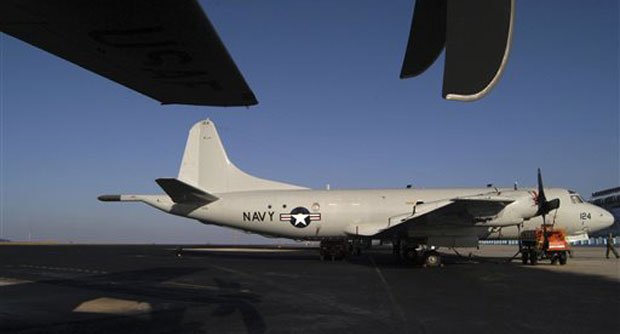Satellites to binoculars used in Flight 370 search

In this Feb. 9, 2005 file photo, a United States Navy P-3C Orion aircraft sits on the tarmac during the Aero India 2005, at the Air Force Station in Yelahanka, near Bangalore, India. The similar type of the P-3 Orion, favored by the Australian and New Zealand defense forces, is used in the search for the Malaysia Airlines Flight 370 which went missing on March 8, 2014, off the west coast of Australia. AP
From satellites to binoculars, the hardware being used in the search for the missing Malaysian plane off Australia’s west coast ranges from the sophisticated to the simple. Here’s a look at some of the equipment being used in the search for Flight 370, which went missing on March 8.
ORION PLANES:
The plane most utilized in the search so far has been the Lockheed P-3 Orion, a four-engine turboprop favored by the Australian and New Zealand defense forces. Because the search area in the southern Indian Ocean is so remote—some 2,500 kilometers southwest of Perth—it’s an eight-hour round trip, leaving the planes just two or three hours to search.
One advantage of this plane is that it can fly at low altitudes for long periods. Mike Yardley, an air commodore with New Zealand’s air force, said that his team’s Orion flew at just 200 feet above the water Thursday to stay below thick clouds and fog—which requires intense concentration by the two pilots.
The Orion has a crew of 13, some of whom are stationed on an observation deck to search. As well as using their eyesight, Yardley said they also use a state-of-the-art radar system and three cameras—one infrared, one long-range, and one high resolution. The combination of systems helps them detect almost anything that’s on the surface, he said. The crew also films everything so they can review what they’ve seen after they return to base.
Article continues after this advertisementThe Orion comes equipped with a sonar system for searching below sea level, although it’s not being used in this search, Yardley said.
Article continues after this advertisementOther planes used in the search Friday include a United States Navy P-8 Poseidon, which has been designed for anti-submarine warfare, and a civilian Bombardier Global Express, a long-range corporate jet with state emergency service observers on board. More planes are on the way.
BINOCULARS:
The Norwegian cargo vessel Hoegh St. Petersburg arrived in the area late Thursday and used lights to search overnight.
The Filipino crew of 20 was planning to use binoculars and their eyesight to scour the water Friday. The ship had been carrying a load of cars from South Africa to Australia before being asked to join in the search.
Another commercial ship was due to arrive later Friday and three Chinese naval ships were heading to the area. China also planned to send an icebreaker that happened to be in Perth following a voyage to Antarctica.
Any plane debris that is found will be transported back by the Australian navy ship the HMAS Success, which is due to arrive at the search site Saturday.
BUOYS WITH GPS:
The New Zealand Orion plane dropped two buoys Thursday that will help searchers figure out where any debris might drift. Searchers were also planning to drop more buoys from a C-130 Hercules military transport plane.
The buoys resemble a poster tube, each about 1 meter (3.3 feet) long, with an antenna that transmits a GPS signal that can be tracked by searchers.
The idea is that the buoys drift in a manner similar to any debris, giving searchers clues as to where debris might move over time. The system isn’t perfect—the wind can move the buoys at a different rate than larger objects—but is designed to factor in some of those variables.
IMAGES FROM SPACE:
Satellite images taken by a private company and released by the Australian government appeared to show two large objects, which prompted searchers to investigate further.
However, the images aren’t definitive. They came from a DigitalGlobe satellite that can look left or right, but which gets lower quality images the father to the side it looks.
The satellites aren’t like the all-powerful ones in the movies that can, say, read a license plate from space. The images appear to be little more than smudges to the untrained eye, and need experts to interpret them. One thing experts look for are reflections, which can help indicate whether a smudge is an object or just water movement.
Australian authorities have redirected other commercial satellites to the area to take higher resolution images, which may provide more answers.
RELATED STORIES
Malaysia, Vietnam, Philippines search for airliner carrying 239
PH military joins search for missing Malaysian jet